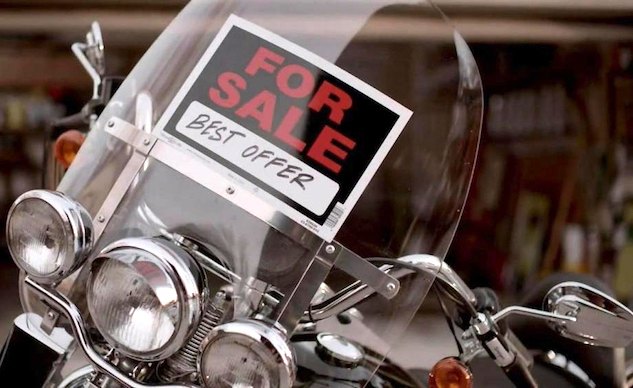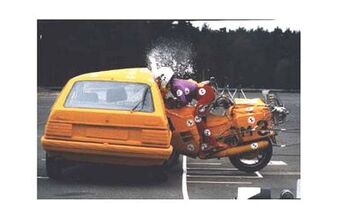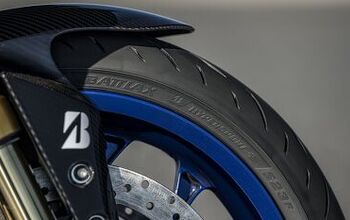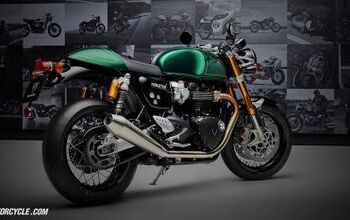10 Tips For Selling A Used Motorcycle
Parting with a loved one is never easy, but when it comes time to put out to pasture your two-wheel friend, there’s no reason you shouldn’t get the best price for it. If you’re like us, you’ll want a good home for the bike that’s been a part of numerous fond memories. Unless, of course, you crashed it. At that point it’s too late. Sell it to anyone with a pulse, swallow the the loss, and move on to greener pastures.
10. Clean & Repair
Looks aren’t everything, but they do mean a lot. Take some time to wash, wax, and repair any cosmetic damage. Not only is a clean bike more attractive, but it conveys to a prospective buyer that you took proper care of your machine.
9. Tune-up
No need to do a complete engine rebuild, but you’re going to be asked to start the bike, and it’s embarrassing – as well as hard to explain – when it doesn’t. Adjust the chain, bleed the brakes, check air pressure, change the oil, etc. To be certain everything’s in working order, refer to the MSF’s T-CLOCS inspection list, and you’ll have your bases covered.
8. Pictures
When there’s 20 of the same model listed, a good photo can make the difference in compelling someone to click on your posting. After you clean and repair the motorcycle, take it somewhere pretty that’ll compliment its colors and/or style. Make sure the background is clean of distractions. Take shots from different angles, and lots of detail photos that prove the bike is as clean as you claim.
7. Service Records/Receipts
Hopefully you’ve kept the records/receipts of all the maintenance performed on the motorcycle. Nothing beats a paper trail to prove good stewardship. Even if you’ve performed some maintenance yourself, it’s a good idea to make a log of date, mileage and work performed.
6. Collect Original Equipment
Like maintenance receipts, hopefully you’ve kept any and all stock items you’ve removed from the motorcycle. The replacements may look or function better, but there’s no reason to keep items belonging to a bike you no longer own, and offering them to the prospective buyer adds value to the deal.
5. Advertise
When it comes time advertise utilize all the tools at your disposal. There are many free sites, like right here on MO, or Craigslist, and then there are pay-to-play sites. Some work better than others.
4. Use Brand Names
If you’re bike is outfitted with recognizable, brand name items – whether stock or aftermarket – be sure to flaunt the name. Brand names such as Öhlins, Brembo, Marchesini, etc., add value, and are good items to revisit when it comes time to negotiate (see #2).
3. Test Rides
Allowing a test ride before money is exchanged is just a bad idea. A prospective buyer may seem honest and claim a solid skillset, but too many things can go wrong. Besides, if the two parties involved can’t agree on a price, the test ride was nothing more than unnecessary risk.
2. Negotiate
The ad you placed may have said “firm,” but nobody believes that’s the case. Haggling is just part of the game, so maintaining a margin between the list price and the amount of money you’ll accept is a good idea. Don’t roll over immediately, no matter how much you’re wanting to make the sale. Some people enjoy haggling just for the fun of it. Some don’t, but you can never be sure. Don’t forget to mention the brand names again, the maintenance records, stock components you’re including, etc. Acting out the pain over the price being offered can also help.
1. Be Ready To Sell
If the negotiations are a success, be ready to finalize the deal. Have the title, registration, any other necessary paperwork ready to go. If you’re not prepared, the deal may be lost. Have a bill of sale, nothing fancy, but something with basic information and signatures. Don’t accept checks, wooden nickels or bitcoins – cash is king.
A former Motorcycle.com staffer who has gone on to greener pastures, Tom Roderick still can't get the motorcycle bug out of his system. And honestly, we still miss having him around. Tom is now a regular freelance writer and tester for Motorcycle.com when his schedule allows, and his experience, riding ability, writing talent, and quick wit are still a joy to have – even if we don't get to experience it as much as we used to.
More by Tom Roderick






































Comments
Join the conversation
Research the going price and be realistic. Just because YOU own it, doesn't make it worth any more.
Don't think you can add the price of all the extras to the price of the bike. Nobody cares, they are comparing base price. Good extras will make it easier to sell though.
If someone wants to test ride, I offer to let them ride on the back. I will show them how it runs, and shift through all the gears.
Don't look at the price of excellent condition bikes and price your beat up, high mileage bike the same. Condition makes all the difference. Be honest, if the bike has problems, let the buyer know about them.
Never, never, advertise a bike as 'Best Offer'. You will get nothing but crazy low ball offers. Don't waste your time talking to anyone that offers you less than 90 percent of your asking price. I only accept cash or cashier's checks, from a local bank.
If you get the type of buyer that tries to nit pick your bike to death and then gives you a low ball offer, don't argue with him, just tell him politely that he should go look at some other bikes. If you are asking $8,000 and he offers you $3,000, suggest that he needs to look at bikes in his price range. If the buyer says he needs to get his financing in order, take a non refundable deposit and give him a maximum of 7 days.
Make it very, very, clear that you are selling the bike 'as is', and that you will not be responsible for any repairs that might be needed after purchase. Put it on the Bill of Sale, "Bike is being sold 'as is' no warranty expressed or implied".
I've sold lots of bikes, never had an unhappy buyer.
What the HELL do they mean by #3? You should NEVER, under any circumstances even CONSIDER buying a used motorcycle without test riding it first! Especially if it's a sport bike. So many rocket riders are "thrashers" where there was basically no "break in" on the bike when it was new, and they won't shift until "red line" because they think it "sounds cool". Those engines are TRASH at 10,000 miles. Better yet, insist on a test ride to a licensed and certified mechanic and have it checked out first before ANY money changes hands.